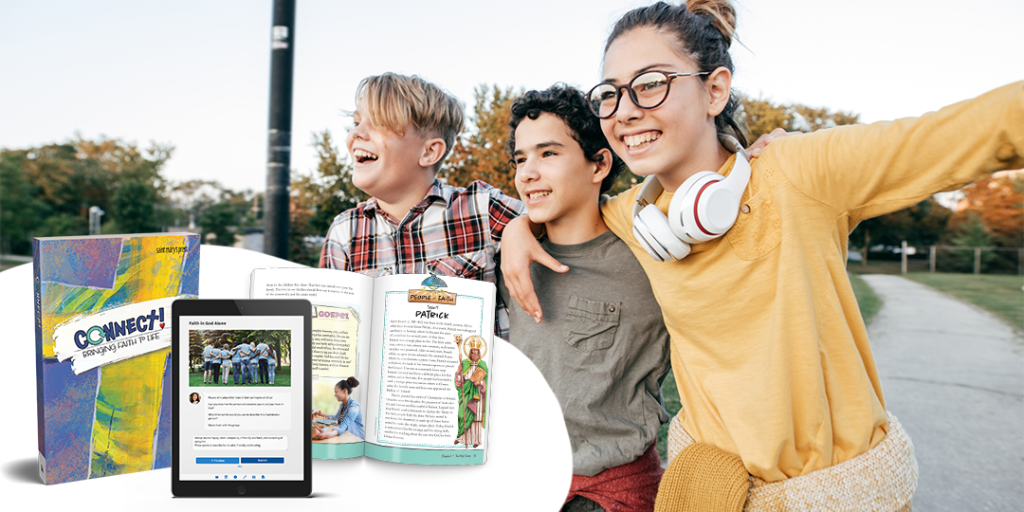
Bringing Faith to Life for Middle Schoolers!
Have you ever had the experience of revealing to others that you teach young adolescents only to have them say, “That’s nice!” when their faces seem to say, “Why would you do that?” Even other teachers and catechists often state that only a truly special person can teach the middle-school grades and that they, themselves, could never do it. These reactions are likely the result of an experience and understanding that the middle-school years are a time of tremendous change and development. This is true. But these years can also be some of the most exciting and impactful for learners, and some of the most rewarding for teachers.
In terms of faith, the middle-school years have been shown to be quite critical in determining a person’s long-term identification as Catholic, so our attention and care do need to be truly special. Let’s explore some key elements that can help support a successful teaching ministry with young adolescents. By focusing on and attending to these elements, we can experience enlivened classrooms, engaged learners, and the knowledge that we are taking positive steps to help bring faith to life for middle schoolers!
1. Get to Know Them
Whether we have been working with middle schoolers for some time or are brand new to the role, it is essential to understand the various characteristics that help define young adolescents as this age. We must get to know the scope of physical, intellectual, emotional, social, moral, and spiritual characteristics that identify middle schoolers. Doing so can help us more specifically structure our classes and tailor our approach in a way that honors them where they are at in their development. We must also strive to know something about their individual lives and interests in order to best connect faith to life.
2. Keep Creativity and Engagement High
If we truly understand the developmental characteristics of middle schoolers, we know that now is the time to make our classes as creative and engaging as ever. With all the changes young adolescents are experiencing, they are easily distracted by other things. Our classes must, therefore, be well-planned, creative, full of engaging learning activities, and filled with various methods to explore core faith topics. Engaging debates and conversations, out-of-the-seat learning activities, avenues for artistic expression and reflection, and skits and roleplays are just a few examples of ways to enliven and spark learning.
3. Make Content Meaningful
Faith in the abstract is way more difficult to grasp for young people than faith applied to their lived experience. It is crucial to demonstrate how learning about faith can impact us and the world in profound ways. Young adolescents are filtering information through the lens of “What difference does this make?” It’s our role to show them, in real terms, how faith can make a difference and how it can affect, enrich, and provide insight and guidance to real-life experiences and everyday situations.
4. Welcome Questioning
Although young adolescents are influenced by the thoughts and beliefs of peers, family, and community, and they still have a strong need to belong, they are also developing critical thinking skills, increased communication skills, and are likely beginning to move away from religious imagery, beliefs, and practices of childhood. This can create a desire to explore faith through questioning, challenging, and/or expressing doubts or disagreements. It is essential that we create an environment where questions are welcomed and encouraged. Helping middle schoolers explore their questions and express their thoughts is one of the biggest gifts we can offer as this process can, ultimately, lead to owned faith.
5. Be Present
One of the spiritual characteristics of middle schoolers is that they commonly seek adult role models who live faith authentically. Young adolescents are looking for examples of what it really means to live faith and how that affects a person’s decisions and actions. Simply put, they are watching everything we do and say and are, in part, evaluating faith in terms of the impact they see it having on our lives. Many people can name a specific person as one of the key reasons they chose to practice their faith. The importance of this cannot be underestimated. In fact, our role as a model of faith might be one the most important elements in helping faith come to life for middle schoolers.
Our attention to and care for the individuals who make up our learning environments is a core part of our role as Catholic educators. By truly understanding those who are in front of us, providing engaging lessons with meaningful content, allowing and encouraging the exploration of honest questions, and being the best role model we can be of faith in action, we will nurture faith and help it to come to life for middle schoolers.
Bring faith to life for middle schoolers with Connect! Bringing Faith to Life
Connect! Bringing Faith to Life welcomes sixth through eighth graders into an exploration of the Catholic faith that connects the lessons to their lives! Every lesson is easy to understand and filled with active, engaging activities that ensure all young people are empowered to dive into the four pillars of the Catholic faith.
And with Bible-focused lessons, tweens won’t just learn about the Bible . . . they’ll learn from the Bible itself!


